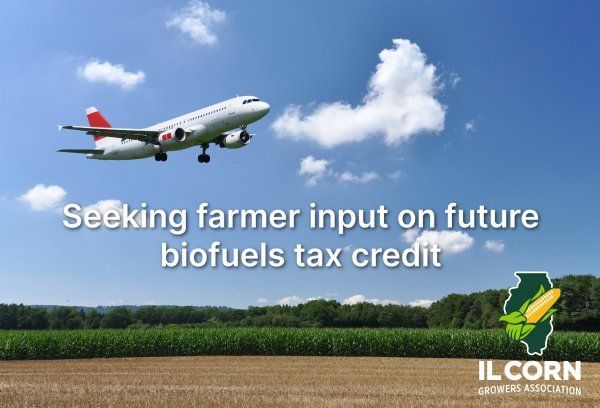USDA Looks For Input Developing Sustainable Aviation Fuel Tax Credit

Illinois farmers have an important role in the development of a new tax credit that offers U.S. ethanol plants incentives to produce lower carbon intensity (CI) biofuels from corn. The USDA is currently seeking advice regarding the conservation practices you’re using or would consider using on your farms that could lower the CI score of your corn, making lower CI biofuels.
BACKGROUND
A 40B tax credit for ethanol plants producing lower carbon intensity ethanol was released in May 2024. The tax credit was too late to influence management decisions on farms and is being used as guidance regarding how a future tax incentive would be built. Now, the USDA is assisting the U.S. Treasury to develop the next tax credit, 45Z, scheduled to be released in January 2025.
The 40B tax credit included a provision that recognized on-farm conservation practices as having a role in reducing the CI scores of transportation fuels – specifically sustainable aviation fuel. This is an important transition in thinking! However, 40B required a suite of three conservation practices to all be used for the corn you’re growing to lower the CI score of the ethanol enough to qualify for the tax credit.
ICGA knows that using nitrogen efficiency, minimum tillage, and cover crops on all the acres in Illinois is impossible. Regulators building these policies do not understand that soil types, regional weather patterns, and other considerations make a simple standard like this unworkable.
View the Federal Register notice here.
WHAT HAPPENS NEXT
Your association will submit answers to the 26 questions posed by the USDA regarding a proposed tax credit. These answers are due on Thursday, July 25. As we develop our answers, your input is critical to help us determine what you believe would be workable on your farm.
In addition to suggesting conservation practices to the USDA, our answers will highlight opportunities for reasonable data management systems to record and report what you are doing on your farm. If you have ideas of minimally burdensome ways to record and share information from an individual field you farm, please share them with us.
IL Corn has been your seat at the table during this process, and we’ll continue to work for a system that is transparent, financially sustainable for Illinois farm families, and open to all farmers who wish to participate, regardless of their proximity to an ethanol plant.
THE IMPACT
How this tax credit is crafted will have potentially large impacts. The measurement of on-farm contributions to lower CI scores may be used as a model in other national and state policy development in the future. Please help your association get these calculations right for today, even as we look for flexibility that incorporates future advances in conservation management decisions and technologies.











































































































